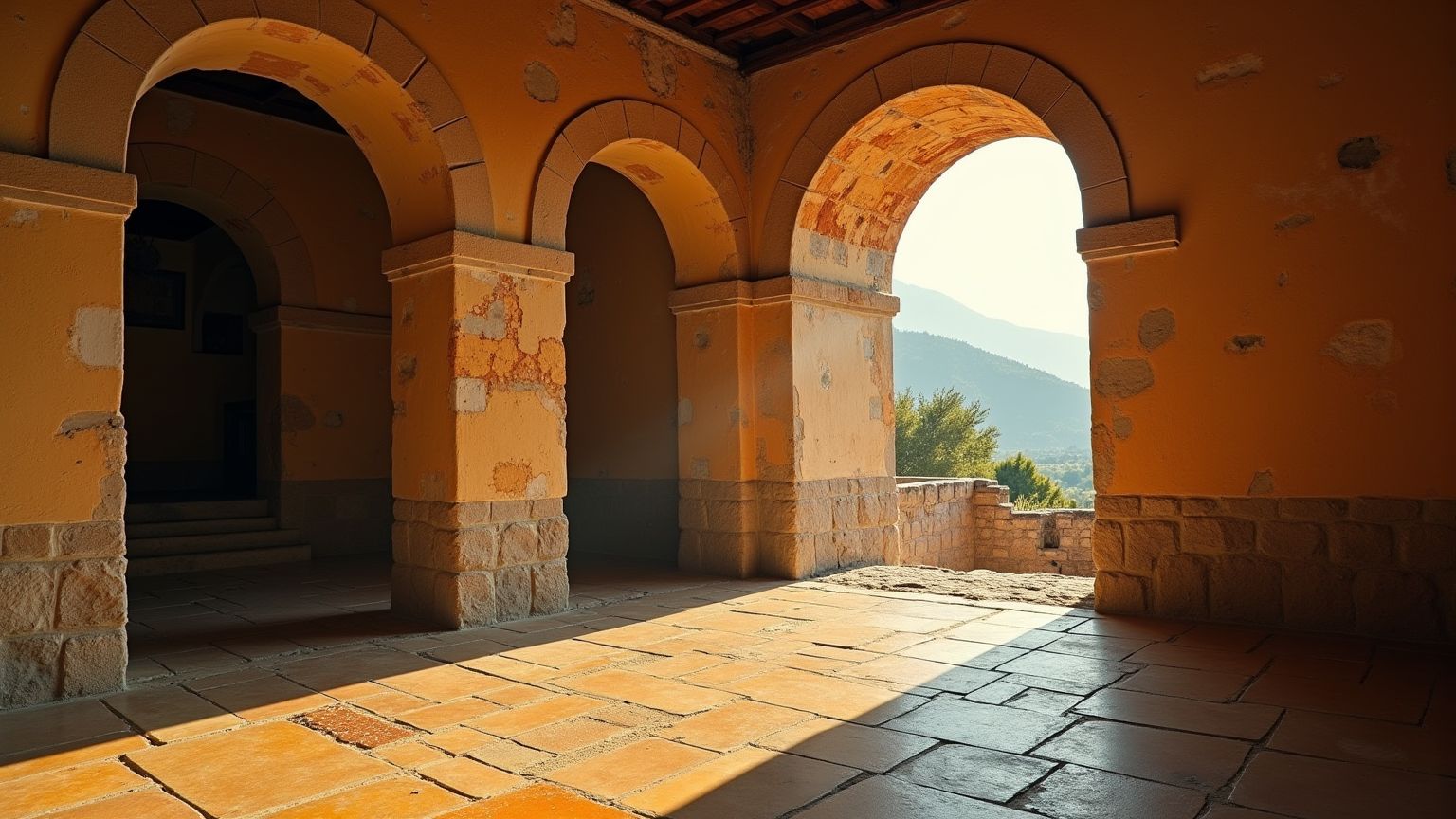Monastery of the Philosopher Near Dimitsana: A Hidden Gem in the Peloponnese Mountains
I've spent the last 20-odd years tramping through every nook and cranny of the Peloponnese as a local guide, and lemme tell you - nothing quite matches that wide-eyed wonder when folks first catch sight of the Monastery of the Philosopher near Dimitsana. Tucked away in the lush folds of Arcadia's Lousios Gorge, this spiritual hideaway remains Greece's best-kept secret. It's not just another pretty building – the Monastery of the Philosopher combines jaw-dropping natural beauty, deep-rooted history, and soul-stirring spiritual significance all in one head-spinning package.
A Journey Through Time: The History of Philosopher's Monastery

The tale of the Monastery of the Philosopher kicks off somewhere in the 10th century Byzantine era, though local oldtimers swear it goes back even further. Named after Ioannis Lambardopoulos (aka "The Philosopher") who founded the place, this hallowed ground has weathered over a thousand years of Greek drama.
What really sets the Monastery of the Philosopher apart in Greece's historical tapestry was its rebellious spirit during Ottoman rule. When Greek cultural identity was being squashed, this place transformed into a "kryfo scholio" (secret school) where young Greeks could still learn their language, faith, and history – basically keeping their identity on life support.
During the 1821 War of Independence, the Monastery of the Philosopher wasn't just sitting on the sidelines – it became revolutionary headquarters and a sanctuary for civilians running from violence. Even the monks rolled up their sleeves and joined the fight, either picking up weapons themselves or patching up the wounded.
Walking through the Monastery of the Philosopher today feels like stepping on hallowed ground. The stones practically whisper revolution, and today's monks tend to the place knowing they're not just maintaining another religious building but safeguarding a cornerstone of modern Greek identity.
Getting to the Monastery: The Journey is Part of the Experience
Half the magic of visiting the Monastery of the Philosopher lies in the journey itself, starting from the mountain town of Dimitsana – roughly 180 kilometers southwest of Athens. With its stone houses that look like they've grown straight out of the hillside and twisty cobblestone streets, Dimitsana makes the perfect launchpad for monastery adventures.
From there, you've got two ways to reach the Monastery of the Philosopher:
By Car:
Head toward Stemnitsa for about 3 kilometers, then follow signs to "Moni Filosofou" or "Monasteries of Lousios Gorge." The road twists and turns like a mountain goat path, serving up postcard-worthy views of the gorge at every hairpin bend. It's paved but narrow with more switchbacks than a mystery novel – drive carefully, especially in winter when the road sometimes wears a treacherous coat of ice.
On Foot (Trust me on this one):
For those who don't mind earning their spiritual enlightenment with a bit of sweat, hike to the Monastery of the Philosopher. The well-marked trail starts at the Open-Air Water Power Museum (worth poking around) and follows ancient paths through the Lousios Gorge. This 3-hour trek takes you through some of Greece's most drop-dead gorgeous landscapes, with the Lousios River providing nature's soundtrack. The path isn't a cakewalk but doable for anyone who won't get winded climbing a few flights of stairs.
Whether you drive or hoof it, start at the crack of dawn. The morning light does magical things to the Monastery of the Philosopher and surrounding mountains – plus you'll beat the crowds, who always seem to arrive just as you're trying to take that perfect people-free photo.
Architectural Marvel: What to Expect When You Arrive
As the Monastery of the Philosopher comes into view, you'll notice how it seems to grow organically from the cliff face, like some medieval builder's fever dream. The complex is actually a two-for-one deal: the Old Monastery (Palaia Moni) and the New Monastery (Nea Moni).
The Old Monastery of the Philosopher, dating back to the 10th century, is partly tucked into a natural cave on the cliff. Only fragments remain accessible today, including a tiny chapel with faded Byzantine frescoes that still pack a visual punch. The sense of age in this space is almost physical – I've watched hardcore history buffs go speechless here, contemplating the centuries of whispered prayers that have bounced off these walls.
The New Monastery of the Philosopher, built in the 17th century, forms the main complex visitors explore today. The showstopper is the katholikon (main church) dedicated to Saint John the Baptist. Step inside and your eyes won't know where to land first – remarkable post-Byzantine frescoes cover nearly every inch of wall space. Don't miss the Last Judgment on the western wall – a religious masterpiece that follows Byzantine traditions while sneaking in some distinctly local touches.
The architecture of the Monastery of the Philosopher reveals both practical thinking and spiritual symbolism:
- Those thick stone walls weren't just for show – they kept invaders out during turbulent times
- The strategic clifftop position offered natural protection and early warning of approaching threats
- The eastward orientation of the church wasn't random – it represents fundamental Orthodox theological concepts
- The use of local materials helped the monastery blend with its surroundings, creating harmony with nature
Spiritual Experience: Visiting an Active Orthodox Monastery
Let's clear something up – the Monastery of the Philosopher isn't some dusty museum piece. It's a living, breathing spiritual community where monks still devote their lives to prayer and contemplation. This adds a dimension you simply won't find at abandoned historical sites.
The Monastery of the Philosopher follows traditional Orthodox monastic rhythms. Visiting hours typically run 9:00 AM to 1:00 PM and 3:00 PM to 5:00 PM, though these shift with the seasons. The place shuts down completely for important religious holidays, so double-check with Dimitsana's tourist office before making the trip.
Dress code alert! Like all Greek Orthodox monasteries, the Monastery of the Philosopher has expectations:
- Men: Long pants (no shorts or swimwear, fellas)
- Women: Skirts or dresses covering the knees (the monastery provides wrap-around skirts at the entrance if you show up in pants or short skirts)
- Everyone: Keep those shoulders covered
When you cross the threshold, one of the resident monks will likely greet you. Some speak English, others only Greek – but their welcome transcends language barriers. You're generally free to explore the main church, courtyard, and public areas, while certain sections remain off-limits as private monastic spaces.
The monks sometimes offer visitors traditional Greek coffee so thick you could stand a spoon in it, cool water, or loukoumi (similar to Turkish delight but don't call it that here). These simple gestures reflect the centuries-old tradition of philoxenia (love of strangers) that remains central to Greek Orthodox monasticism and makes a visit to the Monastery of the Philosopher feel so personal.
Beyond the Walls: The Natural Setting and Nearby Attractions
The setting of the Monastery of the Philosopher hits you like a spiritual sucker punch. Perched on the steep slopes of the Lousios Gorge, the monastery offers views that locals sometimes call "Greece's Mount Athos" – high praise considering the original is Greece's most famous monastic peninsula.
The Lousios Gorge itself deserves exploration. According to local legends that blur the line between history and mythology, this is where Zeus himself bathed after birth – that's where the name "Lousios" comes from, derived from the Greek word for bathing. The river cutting through the gorge is clear enough to count pebbles on the bottom, creating impromptu waterfalls and swimming holes along its journey.
Still got energy after exploring the Monastery of the Philosopher? Continue along the trail to discover other religious gems:
The New Monastery of Prodromos: Another gravity-defying marvel that seems to hang from the cliffs just a short (but sweaty) hike away.
The Old Monastery of Prodromos: Partially cave-built, with 16th-century frescoes that practically pop off the walls with color and detail.
The Ancient Temple of Apollo Epicurius at Bassae: About an hour's drive away, this UNESCO site is one of Greece's best-preserved ancient temples and makes for a fascinating spiritual counterpoint to the Byzantine Christianity of the Monastery of the Philosopher.
Practical Tips for an Unforgettable Visit
After shepherding hundreds of wide-eyed visitors through the Monastery of the Philosopher, I've collected some hard-earned wisdom:
Best Time to Visit
The Monastery of the Philosopher shines year-round, but each season offers its own flavor:
Spring (April-June): Goldilocks weather – not too hot, not too cold – with hillsides carpeted in wildflowers that look like someone spilled a giant paint set.
Summer (July-August): Peak tourist season with warmer temps, but the monastery's thick stone walls keep things naturally cool inside.
Autumn (September-October): My personal sweet spot – golden light bathes everything, the changing foliage creates a natural fireshow, and the summer crowds have vanished.
Winter (November-March): The road less traveled. Snow-dusted mountains create postcard scenes around the Monastery of the Philosopher, but access can be tricky after heavy snowfall.
What to Bring
- Shoes with actual grip – those ancient stone paths turn slippery as a politician's promise when wet
- Water bottle (refillable at the natural spring near the monastery)
- Camera (always ask before photographing inside or snapping monks)
- Small donation for keeping the Monastery of the Philosopher in good repair (not required but good karma)
- Light jacket even in summer – stone buildings hold the cool like natural refrigerators
Where to Sleep
Dimitsana offers several spots to rest your head after a day exploring the Monastery of the Philosopher:
- Nerida Boutique Hotel: Old-school architecture with new-school comforts
- En Dimitsani Guesthouse: Family-run place where you'll be treated like a long-lost cousin
- Kazakou Guesthouse: Nothing fancy but clean rooms with million-dollar views
Local Grub
After communing with higher powers at the Monastery of the Philosopher, treat your earthly body to Arcadia's hearty mountain cuisine:
- Dipnosofistirion: Located in Dimitsana's main square, they serve rooster with hilopites (handmade pasta) that could make a monk break fast.
- Klimataria: Their slow-cooked lamb falls off the bone if you just look at it funny, paired perfectly with wild mountain greens.
- Enastron: The place to sample local cheeses and wines from small Arcadian vineyards that rarely make it beyond these mountains.
A Transformative Experience: Why Moni Filosofou Stays With Visitors
What makes the Monastery of the Philosopher stick with you isn't just its history or architecture – it's how the place seems to exist in multiple dimensions at once. It's a physical location of heart-stopping beauty, a historical document written in stone and fresco, and a living spiritual community carrying ancient traditions forward.
Many visitors tell me their time at the Monastery of the Philosopher moved something in them they didn't expect, regardless of their personal beliefs. There's something about this combo of natural grandeur, human creativity, and spiritual devotion that digs at deeper questions about our place in the grand scheme.
In our world of constant notifications and digital noise, the Monastery of the Philosopher offers a rare chance to step outside modern life – even briefly – and connect with something that endures. This place has witnessed empires crumble, survived wars and earthquakes, and kept its quiet rhythm of prayer through it all.
Standing on the ancient stone terraces of the Monastery of the Philosopher, gazing over views that have inspired monks for a millennium, you can't help but gain perspective. Suddenly, that work deadline or social media drama seems less earth-shattering against the backdrop of such timeless beauty and dedication.
I've returned to the Monastery of the Philosopher hundreds of times as a guide, and it never fails to work its magic. Each visit reveals something new – a previously unnoticed detail in the frescoes, different qualities of light on the stone walls, or an unexpected conversation with a monk that shifts something in my understanding.
The Monastery of the Philosopher near Dimitsana isn't just another tourist box to check – it's an experience that becomes part of your personal story, a memory that will ambush you years later when you least expect it. In sharing this hidden gem, I'm not just pointing you toward a remarkable historical site, but inviting you to discover a different way of seeing the world, if only for an afternoon in Arcadia's mystical mountains.








